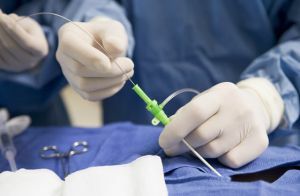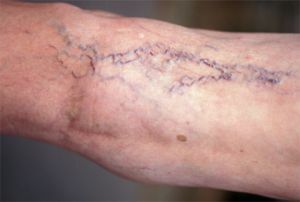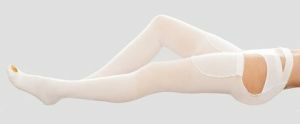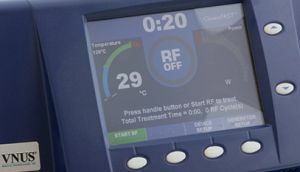 This method has come to phlebology from cardiac surgery, where radiofrequency is successfully used to improve the heart rate in the affected areas of the conduction system of the heart.
This method has come to phlebology from cardiac surgery, where radiofrequency is successfully used to improve the heart rate in the affected areas of the conduction system of the heart.
In the field of treatment of varicose veins, radiofrequency ablation( RFA) is a minimally invasive way of interrupting the conductive function of the patient vein. Can be used in conjunction with other methods of treatment, including invasive.
The method was developed and first applied in 1998 in Europe. In the future, RFA has spread in America, Asia and other countries of the world.
Contents
- What is the therapeutic effect of the procedure
- Indications for the procedure
- When to abandon the procedure
- Preparation for the procedure
- How the procedure passes
- Advantages and disadvantages of this method of exposure
- Rehabilitation and recovery
- Opinion of doctors and patients who have undergone the procedure
- Procedure costs for
- Conclusions
What is the basis for the therapeutic effect of the procedure
The term "ablation" itself means the process of evaporation of a substance.
The method is based on the application of a current of radio-frequency energy with a frequency of 300-750 kHz. The source of this energy is a conventional electric generator that produces a current of the required frequency.
Radio frequency current is delivered to the vein cavity by means of a special catheter that is inserted into the vein with a needle. The catheter moves up the vein to a height equal to the estimated length of the vein to be removed.
Then the generator turns on and a current starts acting on the vein, which heats the walls of the vessels to 120 degrees. Earlier, obliteration was carried out at 80 degrees, because it was believed that a large temperature can burn the tissues located nearby. When using this temperature, the procedure was performed many times longer.
During the heating of the vein, destructive processes occur in which it is sclerized. The principle of vein removal is similar to sclerotherapy, but unlike it, radiofrequency ablation of veins does not require the introduction of a special sclerosing agent.
Indications for the procedure
The main indication for the procedure is varicose veins in the middle stage of neglect. 
It is also advisable to perform surgery for post-thrombotic disease and venous insufficiency C2 class and above.
Before the RFA, an ultrasound scan of the veins of the lower extremities is performed to determine the feasibility of performing the procedure and determining the size of the diseased vein.
The operation should be carried out by a phlebologist, who has experience with ultrasound devices designed to study the body.
When to abandon the procedure
Obliteration is contraindicated in the presence of acute thrombophlebitis in the area of the procedure.
An important obstacle to ablation is ultrasound twisting of the vein, this will not allow a normal passage of the catheter along it. Discomfort also brings a narrow vein( no more than 4 mm), such a vein forces the doctor to perform the procedure of heating the veins from the first time.
 Dangerous and unpredictable thrombosis of the portal vein, are symptoms that should be alerted.what you need to know about the prevention of the disease you can find out in our material.
Dangerous and unpredictable thrombosis of the portal vein, are symptoms that should be alerted.what you need to know about the prevention of the disease you can find out in our material. The method of treatment of varicose disease without surgery phlebosclerosis is also an effective and safe way to solve the problem. We suggest to study the details.
Preparing for the
procedureThe use of radiofrequency ablation of the veins obliges the patient to perform a series of preliminary examinations. The main one is duplex scanning of vessels. It is necessary for the analysis of the venous system and assessment of the patency of the vessel assigned to removal.
Also necessary is a general blood test, an HIV test, hepatitis, syphilis. Such tests will determine the immunity of the body and its ability to transfer the procedure. It is recommended to make a koalogram and an ECG.
How is the procedure
 ? Using ultrasound, a lumen of the vein is inserted into which a specially designed radio-frequency catheter is inserted for the required length of the pathological vein.
? Using ultrasound, a lumen of the vein is inserted into which a specially designed radio-frequency catheter is inserted for the required length of the pathological vein.
Then an anesthetic is injected around the vessel. This allows not only to anesthetize the place, but also to separate the vessel from nearby tissues.
Then the generator is turned on, which supplies the alternating current to the endovascular catheter.
During one turn on the generator, about 7 centimeters of the vein is handled. After that, it is temporarily disconnected and the catheter is carefully moved by pulling it to the injection site. So step by step, during several inclusions of the generator remove the necessary part of the vein.
After the catheter is exposed to the outside, a sterile dressing is applied to the injection site and compression of the limb is carried out using a stocking or special bandage.
Advantages and disadvantages of this method of exposure
Advantages of radiofrequency ablation of veins compared with other methods of removal or treatment of varicose veins:
- minimal soreness;
- the speed of the procedure;
- relatively short rehabilitation period;
- absence of scars and scars;
- low probability of recurrence( 10%).
As with any, even minimally invasive, RFA venous remedy also has its drawbacks:
- skin burns;
- thrombosis;
- occurrence of inguinal reflux;
- blistering.
Rehabilitation and recovery
Use of compression linen is compulsory for a minimum of forty minutes. And this time needs to be spent in walking( walking).It  is necessary to prevent thrombosis.
is necessary to prevent thrombosis.
In the first two weeks, the use of compression knitwear is necessary.
Every day a patient should make walks( not less than an hour).
After a few days, it is necessary to perform ultrasound angioscanning to determine the success of the procedure.
Opinion of doctors and patients who have undergone
procedure Let's study the responses of doctors and patients who were assigned radiofrequency obliteration of veins.
Radiofrequency obliteration of veins is a unique method of treatment of vertical venous reflux.
And it is used for thermal destruction of veins with a diameter of 4 mm to 20 cm. The doctor's experience and strict observance of the rules of the procedure will allow to achieve the most positive results and almost absolute absence of complications.
Doctor-phlebologist Konstantin Vasilyevich, 45
When my varicose veins reached the second degree of complexity, I decided to perform sclerotherapy for the sick veins that I found on the Internet.
But after consulting with the doctor and conducting some tests, the doctor said that I have contraindications to the introduction of a sclerosing substance into the body. Then to me have advised a similar method of excision of a vein, namely radiofrequency ablation. It was much more expensive, but it did not bother me.
The procedure was without complications and painful sensations. I'm happy with the result.
Elena, 35
I had a neglected varicose veins. I managed to reach the point where I had to not only remove them, but also apply radio frequency ablation in parallel.
Because of the large number of diseased veins, the removal of each would contribute to the formation of many scars. Therefore, doctors urged to conduct RFA, rather than standard surgical treatment.
Michael, 45
Somewhere half a year ago on my leg I got a vein. I decided not to wait for the emergence of new ones and an increase in the existing one. Therefore, first of all went to the center of phlebology, where I was advised to do radio-frequency obliteration of veins.
I agreed and went through the procedure, it passed quickly and almost painlessly. Now my legs are all right.
Lyudmila, 29
The prices for the procedure
The prices depend on the venue and are: 
- In the innovative phlebology center of Dr. Letunovsky, the cost of the procedure is about 1800 euros( about 115,000 rubles) .
- In the medical center "Algida" the cost of RFA depends on the degree of complexity and fluctuates in the range 45-70 thousand rubles .
- The average cost of the procedure in the Moscow clinics is 55 thousand rubles.
Conclusions
Radiofrequency ablation( obliteration) of veins is an effective minimally invasive method of treating varicose veins.
Unlike usual surgery, the vein is not simply removed, but destroyed, as a result of exposure to high temperature, and no longer fulfills its function. And unlike sclerotherapy, RFA does not require the introduction of special acids into the body leading to the destruction of the vessel.
